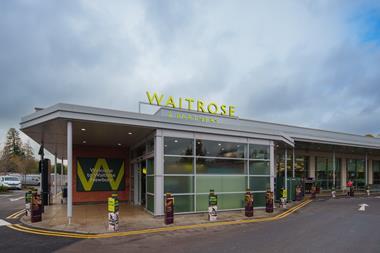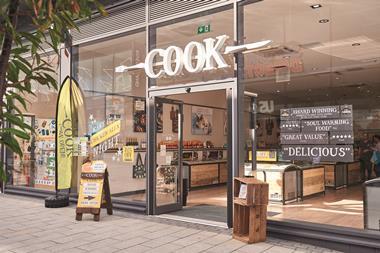Emerge blinking from the bowels of Russell Square underground station in central London and you'll find yourself at the Brunswick - the retail and accommodation complex that has become an icon of 1960s architecture and is now Grade II listed.
This status hasn't prevented a £25m refurbishment that will lead to the creation of an outdoor shopping centre with the new Waitrose Bloomsbury at its heart. The store was the first unit to open and has already caused a stir locally.
Residents are reportedly delighted finally to have what branch manager Neil Ovenden calls "a full assortment supermarket in an area that's been missing one".
The store, Waitrose's 180th, lies at the end of a long arcade of empty shops, most bedecked with signs heralding new arrivals - coming soon are Carluccio's, Oddbins and well-known fashion outlets.
It's a retail mix destined to draw people from the Brunswick's diversely populated catchment area. This includes the 408 apartments in the complex itself, London's biggest university campus, UCL, thousands of families of mixed ethnicity living out towards the east, and the hordes of tourists visiting London's museums and theatres to the south west.
On entering the new 23,500 sq ft Waitrose store, there is a specific food-to-go zone designed to deal with the lunchtime crowd. Here, chillers and shelves are stocked with a wide range of sandwiches, sushi, crisps, snacks, and prepared fruit.
Six basket-only checkouts service the area.
The idea, says Ovenden, is to keep the lunchtime crowd, mainly office workers, and the regular shoppers apart. "This way, they don't get in each other's way," he says. As we tour the aisles, Ovenden points out where the store has adopted merchandising practices that deviate from the norm - all designed to appeal to its diverse customer base.
On the pre-pack cheese counter, for instance, Cheddar occupies far less space than would normally be expected. Prominence is given instead to a range of Mozzarellas, Fetas and Parmesans - popular with ethnic clientele and sophisticated Londoners alike.
This methodology is also apparent in the yoghurts fixture, where, unusually, a wide range of natural yoghurt products reflects the store's ethnically diverse customer base - and the demand from health-conscious shoppers. There are other subtle touches - more premium pastas in the Italian aisle (including unusual varieties such as Giganti which, says Ovenden, "adds drama to food"), a large free-from range, a line of pricey Poilâne bread and loads of olive oils.
At the back of the store sit counters for fish, meat, cheese, deli goods, hot food and baked products. The cheese 'counter' is arguably its most striking feature. There is no counter, the cheeses being arranged on shelving staffed by a server who cuts and packs on equipment next to the fixture. Customers are able to get up close to the cheese, creating a far less intimidating fixture to shop than the traditional counter behind glass. It is the second such installation - there is also one at Waitrose
Belgravia - and has proved a huge success, says Ovenden. In a ranking of all of Waitrose's stores, Bloomsbury already stands 15th in terms of sales of loose cheese.
Initiatives such as this one in the store are all geared towards the diverse customer-base, and they are all very much at trial stage. But, says Ovenden, if they are successful, Bloomsbury Waitrose could act as a blueprint for other city stores nationwide.
"We invested a lot of time in researching London shoppers' behaviour and this store reflects the way London people shop," he says. "But our way of merchandising could also suit customers in Bath, Brighton and Edinburgh because, like those in London, they have a city mentality."catchment profile
The catchment profile is dominated by urban prosperous and hard-pressed (40% and 49% respectively)
The proportion of hard-pressed in the catchment is above the London average and well above that of a typical Waitrose
This is partially offset by the large proportion of urban prosperous, which constitutes 21% of the typical Waitrose catchment
The division between the educated urbanites and inner-city adversity groups means that no national retailer would have an especially good fit to the catchment profile. However, Waitrose does perform particularly strongly among educated urbanites
The affluent worker population will provide a major source of customers and, being located near a tube station, the store is well positioned to serve this demand
This status hasn't prevented a £25m refurbishment that will lead to the creation of an outdoor shopping centre with the new Waitrose Bloomsbury at its heart. The store was the first unit to open and has already caused a stir locally.
Residents are reportedly delighted finally to have what branch manager Neil Ovenden calls "a full assortment supermarket in an area that's been missing one".
The store, Waitrose's 180th, lies at the end of a long arcade of empty shops, most bedecked with signs heralding new arrivals - coming soon are Carluccio's, Oddbins and well-known fashion outlets.
It's a retail mix destined to draw people from the Brunswick's diversely populated catchment area. This includes the 408 apartments in the complex itself, London's biggest university campus, UCL, thousands of families of mixed ethnicity living out towards the east, and the hordes of tourists visiting London's museums and theatres to the south west.
On entering the new 23,500 sq ft Waitrose store, there is a specific food-to-go zone designed to deal with the lunchtime crowd. Here, chillers and shelves are stocked with a wide range of sandwiches, sushi, crisps, snacks, and prepared fruit.
Six basket-only checkouts service the area.
The idea, says Ovenden, is to keep the lunchtime crowd, mainly office workers, and the regular shoppers apart. "This way, they don't get in each other's way," he says. As we tour the aisles, Ovenden points out where the store has adopted merchandising practices that deviate from the norm - all designed to appeal to its diverse customer base.
On the pre-pack cheese counter, for instance, Cheddar occupies far less space than would normally be expected. Prominence is given instead to a range of Mozzarellas, Fetas and Parmesans - popular with ethnic clientele and sophisticated Londoners alike.
This methodology is also apparent in the yoghurts fixture, where, unusually, a wide range of natural yoghurt products reflects the store's ethnically diverse customer base - and the demand from health-conscious shoppers. There are other subtle touches - more premium pastas in the Italian aisle (including unusual varieties such as Giganti which, says Ovenden, "adds drama to food"), a large free-from range, a line of pricey Poilâne bread and loads of olive oils.
At the back of the store sit counters for fish, meat, cheese, deli goods, hot food and baked products. The cheese 'counter' is arguably its most striking feature. There is no counter, the cheeses being arranged on shelving staffed by a server who cuts and packs on equipment next to the fixture. Customers are able to get up close to the cheese, creating a far less intimidating fixture to shop than the traditional counter behind glass. It is the second such installation - there is also one at Waitrose
Belgravia - and has proved a huge success, says Ovenden. In a ranking of all of Waitrose's stores, Bloomsbury already stands 15th in terms of sales of loose cheese.
Initiatives such as this one in the store are all geared towards the diverse customer-base, and they are all very much at trial stage. But, says Ovenden, if they are successful, Bloomsbury Waitrose could act as a blueprint for other city stores nationwide.
"We invested a lot of time in researching London shoppers' behaviour and this store reflects the way London people shop," he says. "But our way of merchandising could also suit customers in Bath, Brighton and Edinburgh because, like those in London, they have a city mentality."catchment profile
The catchment profile is dominated by urban prosperous and hard-pressed (40% and 49% respectively)
The proportion of hard-pressed in the catchment is above the London average and well above that of a typical Waitrose
This is partially offset by the large proportion of urban prosperous, which constitutes 21% of the typical Waitrose catchment
The division between the educated urbanites and inner-city adversity groups means that no national retailer would have an especially good fit to the catchment profile. However, Waitrose does perform particularly strongly among educated urbanites
The affluent worker population will provide a major source of customers and, being located near a tube station, the store is well positioned to serve this demand



















No comments yet